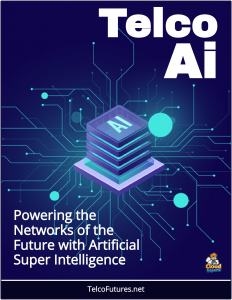 The telecommunications industry is undergoing a transformative shift, moving from smart networks to sentient systems powered by artificial intelligence (AI).
The telecommunications industry is undergoing a transformative shift, moving from smart networks to sentient systems powered by artificial intelligence (AI).
This evolution is driven by the need to manage increasing data demands, optimize resources, and deliver personalized user experiences.
As networks become more intelligent, they are poised to redefine connectivity, autonomy, and efficiency.
The Rise of Smart Networks
Smart networks, built on software-defined networking (SDN) and network function virtualization (NFV), have enhanced flexibility and efficiency in telecommunications. These technologies allow dynamic resource allocation and real-time management, addressing the growing complexity of data traffic, which Cisco’s Annual Internet Report projects will reach 4.8 zettabytes annually by 2022. The integration of 5G has further accelerated this shift, enabling low-latency, high-speed connectivity for applications like autonomous vehicles and IoT ecosystems.
AI is central to smart networks, with machine learning (ML) algorithms optimizing traffic routing, predicting demand, and detecting anomalies. For example, AT&T uses AI to analyze network patterns, reducing congestion and improving reliability. These advancements have laid the groundwork for more autonomous systems, but smart networks still rely heavily on human oversight and predefined rules.
The Emergence of Sentient Systems
Sentient systems represent the next frontier, characterized by self-awareness, autonomous decision-making, and adaptability. Unlike smart networks, which follow programmed instructions, sentient systems learn from their environment, anticipate needs, and act proactively. This leap is enabled by advancements in generative AI, neural networks, and edge computing, allowing real-time data processing closer to the source.
Ericsson’s vision of “cognitive networks” highlights this shift, where systems self-optimize and predict failures before they occur. For instance, Nokia’s Bell Labs is developing AI-driven networks that adjust bandwidth dynamically based on user behavior.
These systems could reduce operational costs by up to 20%, according to Deloitte, while improving energy efficiency—a critical factor as 5G networks consume significantly more power than 4G.
Key Technologies Driving Sentient Systems
Several technologies are propelling this transition. Generative AI enables networks to simulate scenarios and optimize configurations autonomously. Edge computing reduces latency by processing data locally, crucial for applications like smart cities.
Quantum computing, though still nascent, promises to enhance encryption and solve complex optimization problems. Companies like IBM are exploring quantum algorithms for network management, potentially revolutionizing security and efficiency.
The integration of 6G, expected by 2030, will further enable sentient systems. With terahertz frequencies and AI-native architectures, 6G will support massive device connectivity and holographic communications, as outlined in Samsung’s 6G vision. These advancements will require networks to operate with unprecedented autonomy and intelligence.
Transforming Industries
Sentient systems will impact various sectors. In healthcare, AI-driven networks could prioritize data from critical devices, enabling real-time remote surgeries. In transportation, they could optimize traffic flow for autonomous vehicles, reducing congestion and emissions. Smart cities could leverage sentient systems for efficient resource management, such as dynamic energy allocation based on real-time demand.
For consumers, sentient systems promise hyper-personalized experiences. Networks could adjust streaming quality based on user preferences or prioritize bandwidth for critical tasks. However, this personalization raises privacy concerns, as sentient systems require vast amounts of data to function effectively.
Challenges and Ethical Considerations
The shift to sentient systems presents significant challenges. Data privacy is a primary concern, with regulations like GDPR and CCPA imposing strict guidelines on data usage. A 2023 Ponemon Institute study found that 65% of consumers worry about AI-driven data collection, highlighting the need for transparent practices.
Cybersecurity risks also escalate as networks become more autonomous. Sentient systems, with their interconnected nature, are vulnerable to sophisticated attacks. The 2020 SolarWinds hack demonstrated the potential scale of such threats, emphasizing the need for robust security frameworks.
Ethical AI development is another hurdle. Sentient systems must avoid biases embedded in their training data, which could lead to unfair resource allocation. For example, biased algorithms might prioritize certain demographics for bandwidth, exacerbating digital divides. Ensuring fairness requires diverse datasets and continuous monitoring.
The Road Ahead
The transition to sentient systems is underway but faces technical and regulatory hurdles. Developing AI models that operate reliably in dynamic environments is complex, and integrating quantum computing into mainstream networks is still years away. Collaboration between telecom operators, tech companies, and regulators is essential to establish standards for interoperability and security.
Investment in sentient systems is growing, with global spending on AI in telecom expected to reach $11 billion by 2025, per IDC. Companies like Huawei and Verizon are leading the charge, deploying AI-driven solutions to enhance network autonomy. However, scaling these systems globally requires addressing infrastructure disparities, particularly in developing regions.
Conclusion
The evolution from smart networks to sentient systems marks a paradigm shift in telecommunications. By leveraging AI, edge computing, and emerging technologies like 6G, these systems promise greater efficiency, personalization, and autonomy.
Yet, challenges like privacy, security, and ethical AI development must be addressed to ensure equitable benefits. As the industry navigates this transformation, sentient systems have the potential to redefine connectivity, creating a future where networks are not just smart but truly sentient, adapting seamlessly to human needs.
